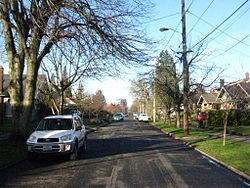Rose City Park, Portland, Oregon
| Rose City Park | |
|---|---|
| Neighborhood | |
 |
|
| Coordinates: 45°32′16″N 122°36′21″W / 45.53777°N 122.60585°WCoordinates: 45°32′16″N 122°36′21″W / 45.53777°N 122.60585°W PDF map |
|
| Country | United States |
| State | Oregon |
| City | Portland |
| Government | |
| • Association | Rose City Park Neighborhood Association |
| • Coalition | Northeast Coalition of Neighborhoods |
| Area | |
| • Total | 1.17 sq mi (3.04 km2) |
| Population (2000) | |
| • Total | 8,903 |
| • Density | 7,600/sq mi (2,900/km2) |
| Housing | |
| • No. of households | 3859 |
| • Occupancy rate | 97% occupied |
| • Owner-occupied | 2857 households (74%) |
| • Renting | 1002 households (26%) |
| • Avg. household size | 2.31 persons |
Rose City Park is a neighborhood (and a park of the same name) in Northeast Portland, Oregon. It borders Beaumont-Wilshire, Grant Park, and the Hollywood District on the west (at NE 47th Avenue), Cully on the north (at NE Fremont Street), Roseway and Madison South on the east (at NE 65th Avenue), and Center on the south (at the Banfield Expressway and MAX transit line).
The neighborhood was platted in 1907, the year of the first Portland Rose Festival. Trolley service from Downtown Portland was inaugurated that year by the Portland Railway, Light & Power Co., and discontinued November 30, 1936.
In addition to its eponymous park (acquired 1920), other parks in the neighborhood include Normandale Park (1940), Frazer Park (1950, on the site of a former juvenile detention center), and the western part of Rose City Golf Course (1920), whose clubhouse was listed on the National Register of Historic Places in 2012. A statue of George Washington was commissioned by Henry Waldo Coe and sculpted by Pompeo Coppini, and dedicated on July 4, 1927. It stands at 57th Avenue and Sandy Boulevard, in the center of the neighborhood. Beginning in March 1946, NABISCO proposed building a large factory on 24 acres (97,000 m2) in the Rose City Park neighborhood, choosing the location for proximity of workers and access to the rail line. The city council approved the zoning change on June 5, 1947, but by June 26, 1947 NABISCO abandoned the project, building a plant at the northern edge of the Piedmont neighborhood on Columbia Boulevard. The plant was completed in August 1950.
...
Wikipedia

